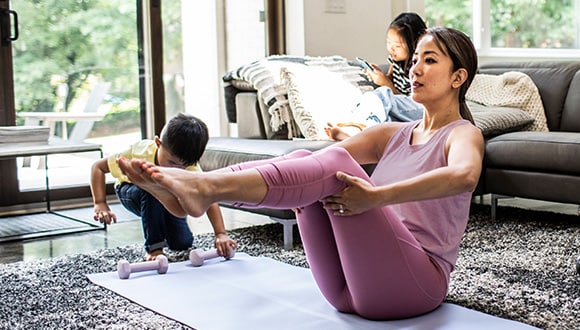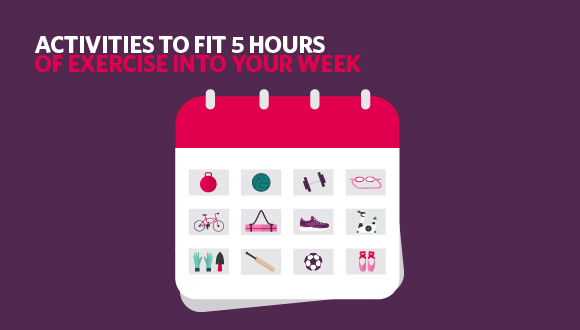HOW TO FIT 5 HOURS OF EXERCISE INTO YOUR BUSY WEEK
Published February 2023 | 5 min read
Expert contributor Sarah King, exercise physiologist and personal trainer
Words by Lucy E Cousins
Carving out time to hit the recommended daily amount of exercise doesn’t have to be challenging. Here’s how to build your endurance up every week.
Fitting exercise into your daily life – between work, socialising and family commitments – can feel really hard, especially for some women.
The recommended guidelines for Aussie adults are 2.5 to 5 hours of moderate intensity exercise weekly, or 1.25 to 2.5 hours of vigorous exercise, but research shows 59% of Aussie females have low activity levels. The key to increasing your movement and hitting the goal of five hours of exercise weekly is small, frequent sessions that fit around your lifestyle and commitments.
“I think we have to be realistic with our expectations around exercise,” says Sarah King, an exercise physiologist and personal trainer. “Perhaps you might feel like you have lost touch with that side of yourself, or you’re a new mum or you’re progressing in your career and working long hours. Either way, the exercise you choose needs to work with your schedule for it to be sustainable.”
Sarah says it’s best to start slowly and not jump into anything too demanding or too physically challenging too quickly.
“Instead of building up slowly, we often decide to jump into things, like an eight-week challenge, and then we get injured. Or, if we complete the program, we feel absolutely exhausted afterwards and then just revert back to doing what we were doing before, which may not have been much at all.”
Sarah recommends starting small and working your way up to the recommended amount of exercise over time. That way your fitness program is more likely to become a habit, rather than a fleeting hobby.

The benefits of regular exercise
Whether you work out to increase your fitness, or because it puts you in a better mood, or you love the social aspects of your tennis club, it’s well documented that regular exercise has many benefits. Not only can it boost your longevity and overall wellbeing, but living an active life can also reduce your risk of heart disease, diabetes and some cancers.
“The most important thing to understand about exercising is that we only get one body, and it has to hold us together throughout our entire life. Taking care of it is the most important thing we can do for our health,” says Sarah.
How to find time to exercise
While you may have great intentions, one of the most common challenges for women can be finding the time to focus on themselves.
If this is an issue for you, focusing on movement in small sessions around your daily commitments may work better than trying to find 60 minutes to get to the gym. Here are some ideas to add in smaller sessions of movement throughout your day:
- If your kids like scooters and bikes, encourage them to go for a ride before or after dinner while you run alongside them.
- Wake up 20 minutes earlier and do a YouTube workout in the mornings.
- Walk around the pitch while the kids are at soccer practice.
- During the workday, consider ‘walking meetings’ or a quick workout during lunch, or walk home from the office, trying different commuting options.
- If you regularly catch up with friends, turn those outings into bush walks, or do virtual fitness sessions with friends online. Tell your friends about your goal to fit in more activity – it’s likely they'll want to do the same.
If you prefer to work out alone, schedule in 30 minutes every day in your calendar where you commit to an exercise. This, says Sarah, is a great way to build up your endurance and confidence.
“If your end goal is to do four or five workout sessions a week, just start with one or two in the first couple of weeks and really give yourself some confidence that you can do that before adding additional sessions as you go.”
And the same goes for intensity, she adds. Just because you can go harder initially doesn't mean you should. Not only does your fitness take time to improve, but your muscles, bones, joints and everything else need time to adapt to the new schedule and a new routine.
What types of exercise should women be doing?
When it comes to the type of exercise, Sarah is quick to point out that small, regular workout sessions offer more benefits than less regular longer sessions.
“Little and often is always better, because the benefits you gain from exercise are dose dependent,” she says. “So, if you do a two-hour hike, those benefits happen in and around that day, they don't last for the other six days of the week.”
Instead, Sarah says, it’s much more achievable for most women to aim for 30 to 45 minutes, four times a week, then build on that. A mixture of cardio and strength/resistance training is recommended.
“You want a minimum of two sessions a week of full-body resistance or strength training,” says Sarah, “as that’s helpful for building muscle mass and maintaining bone mass, which is particularly important for women because as we age, our oestrogen, which is our bone-protective hormone, naturally decreases.”
Then, add in about 150 to roughly 300 minutes (2.5 to 5 hours) of moderate to vigorous intensity cardiovascular exercise a week, she adds, mixed with some elements of exercise that are just enjoyable. That could mean Pilates for balance, yoga for core strength or dog walking for mobility.

Workout programs that hit the recommendation
Building a fitness program is all about making sure you reach your fitness goals, while also including enough enjoyable activity so it’s sustainable. Here are three examples of fitness programs that include both moderate and vigorous exercise to help you achieve the recommended number of minutes per week and boost your fitness and endurance. For advice on whether a fitness progress is right for you, speak to a health professional.
Weekly exercise program #1
- 3 x 45-min walks, including interval fast walking and hill walking
- 1 x 50-min weight/strength class
- 1 x 50-min yoga session
- 1 x 60-min lawn mowing session, vacuuming or vigorously cleaning the house
Weekly exercise program #2
- 4 x 30-min moderate jogging sessions, including fast running intervals
- 1 x 50-min Pilates session
- 2 x 50-min strength session
- 1 x 40-min backyard football, cricket or netball session with your kids
Weekly exercise program #3
- 4 x 30-min swimming, alternating breaststroke and freestyle laps
- 2 x 30-min walking on the treadmill, including fast walking intervals and an incline
- 2 x 30-min dance sessions, including songs with 130 to 170 bpm (beats per minute)
- 1 x 60-min spin class or bike ride
We’re also here to help
Carrying extra weight can take its toll at any stage and age. That’s why we’ve partnered with Prima Health Solutions, to give you free access to our Healthy Weight for Life programs to help you improve your quality of life. These programs are available to members who are overweight and have osteoarthritis* or are at risk of developing a chronic condition^.
RELATED ARTICLES
How exercise boosts mental health
Exercise has the potential to support both your body and your mind.
Exercise for seniors
Find out the best ways to stay fit and well during your senior years.
Which cardio is right for you?
Longer sessions at a moderate pace or less time but much more intensity? We compare the differences between these cardio workouts.
Resistance training for older people
Resistance training is a key part of staying healthy at all ages and stages. Here’s how to integrate it into your daily life.
Important Information
* Must have held hospital cover that covers joint replacement surgery for 2 months, have knee or hip osteoarthritis and a Body Mass Index of 28 and above. Clinical eligibility applies. See hcf.com.au/hwfl
^ Must have hospital cover, multiple lifestyle risk factors (e.g. smoking, physical inactivity, poor nutrition) and a Body Mass Index of 28 and above. Clinical eligibility applies. See hcf.com.au/hwfl
This communication contains information which is copyright to The Hospitals Contribution Fund of Australia Limited (HCF). It should not be copied, disclosed or distributed without the authority of HCF. Except as required by law, HCF does not represent, warrant and/or guarantee that this communication is free from errors, virus, interception or interference. All reasonable efforts have been taken to ensure the accuracy of material contained on this website. It’s not intended that this website be comprehensive or render advice. HCF members should rely on authoritative advice they seek from qualified practitioners in the health and medical fields as the information provided on this website is general information only and may not be suitable to individual circumstances or health needs. Please check with your health professional before making any dietary, medical or other health decisions as a result of reading this website.